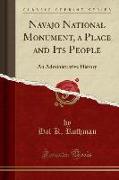- Start
- Navajo National Monument, a Place and Its People
Navajo National Monument, a Place and Its People
Angebote / Angebote:
Excerpt from Navajo National Monument, a Place and Its People: An Administrative HistoryLocated in northeastern Arizona, Navajo National Monument is anomalous among national park areas. The monument contains three distinct and non-contiguous sections, administered from one headquarters. The three sections of the monument, Betatakin, Keet See], and Inscription House, are surrounded by the Navajo reservation. Dating from the i3th century C. E., they contain the primary representation of the Kayenta Anasazi within the national park system. Yet because of their location and the distance between the three areas, Navajo National Monument is an inholding on the Navajo reservation.This condition has created a level of interdependence unequaled elsewhere in the national park system. The monument and its neighbors depend on each other for mutual sustenance. The park provides a range of services not otherwise available as well as significant employment opportunities to the people of the Shonto region. Through a complex series of formal agreements and customs, local Navajos support the park and participate in its activities.Like many other smaller southwestern national monuments, Navajo developed slowly. At its inception, the Park Service had few resources, most of which were used to improve national parks. Navajo National Monument had only a volunteer custodian from its establishment in 1909 until 1938. New Deal development bypassed the monument, and despite the construction of basic facilities, at the end of the 19505 Navajo remained a remote place, inaccessible to most of the traveling public.The initiation of the mission 66 program in the 19505 and an extensive road construction program by the Navajo Nation ended the historic isolation of the monument. Mission 66 planned an extensive development for Navajo, but the plans were held in abeyance until an adequate area of land on which to build a Visitor center could be acquired. A complicated series of attempts to arrange a transfer of land followed, resulting in the Memorandum of Agreement of May 1962. This allowed the Park Service to add 240 acres for development of facilities.About the PublisherForgotten Books publishes hundreds of thousands of rare and classic books. Find more at www.forgottenbooks.comThis book is a reproduction of an important historical work. Forgotten Books uses state-of-the-art technology to digitally reconstruct the work, preserving the original format whilst repairing imperfections present in the aged copy. In rare cases, an imperfection in the original, such as a blemish or missing page, may be replicated in our edition. We do, however, repair the vast majority of imperfections successfully, any imperfections that remain are intentionally left to preserve the state of such historical works.
Folgt in ca. 5 Arbeitstagen




